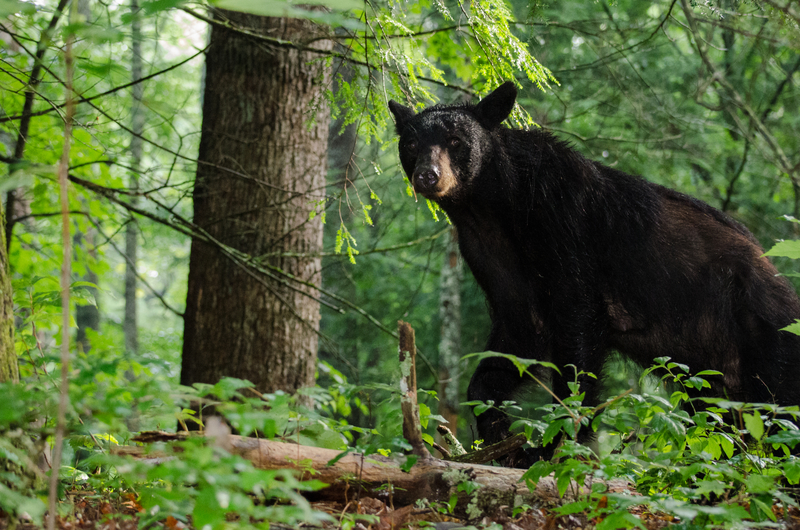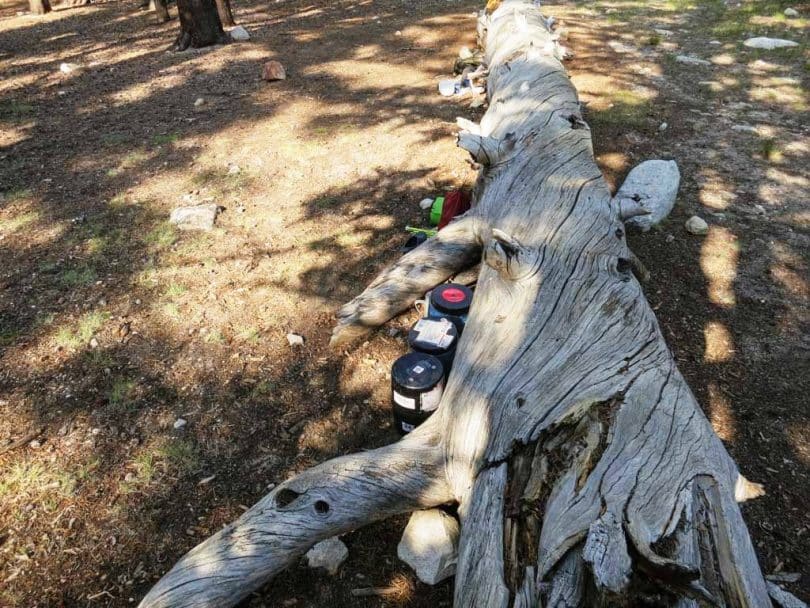There's a common belief that hanging your food from a tree is the best option when it comes to deterring bears, but there's actually a better solution. Learning where to place your food and making a DIY food canister (that takes less than 30 minutes) can keep your camping trips safer and less stressful.
Before you start on our alternative homemade bear canister, check in with the park you are traveling to, some have regulations and fines associated for backpackers traveling without a preapproved bear canister.
*Bear tip: Bears can and will go after food dangling just out of sight, and if they sniff more snacks in the tree, they will be relentless trying to get your food. Unless your container can withstand the force of a bear bouncing it around on the ground and off the tree, it will not help you to hang it up in a tree.
WHY DO I NEED A BEAR CANISTER?
When people think of bear canisters they normally only associate it with only food, but bear canisters should hold anything with a strong odor. Trash from food (think of all the granola bar wrappers in your backpack or pockets!), medications, bait if you are out fishing and even toothpaste.
If you are bringing your beloved pet along, their food will also need to go into a bear canister, as their scent can be just as attractive.
What leads the average backpacker to find alternatives to the classic bear canister or bear keg, is that they tend to be very heavy, ranging from two to three pounds. Also on average, the best bear box is only going to hold about five days’ worth of food and toiletries for one person.
ASPECTS TO CONSIDER
Before you throw it up into the tree, you are going to want to make sure to tie a loop on at least one of the bags so you can snag it down later. This method is difficult, and in some places not permitted, so having a bear canister is really the best way to go.
ODOR PROOF
What you are going to want to do, especially in areas where the bears are common, is purchase odor-negating barrier bags.
SMOOTH AND DURABLE
You want your bears to have little to no leverage to pry open your canister. The best way to do this is to have a slippery or smooth surface that makes it difficult for bears to get their paws around it.
WHERE TO PLACE THE CANISTER
Make sure to place your canisters at least 100 feet away from your actual campsite.
Your canister is going to have one side that twists open, so make sure to plant the canister face down, if you are stashing them below ground.
HOW TO BUILD STEP BY STEP
WHAT YOU NEED
- A 4” PVC pipe
- A 4” pipe cap
- A 4” pipe coupler, which will connect two pipes
- One PVC female thread adapter
- A removal male threaded 4” cap
- One 3” plastic disc, this can be cut from any sturdy plastic material, even a milk jug.
- PVC glue, make sure to get the right type of glue for successful construction!
- Drill
- Saw, preferably a circular saw, but regular hacksaws will also work
- Sand Paper
STEP BY STEP
- First, you are going to want to cut your PVC pipe to the size of your bear canister. Most PVC is not sold in 4″ lengths. Rather than buy two smaller pieces, we suggest cutting longer PVC pipes down to size to reduce any weakness in the overall design. Use either a circular saw or a hacksaw to cut the piece down.
- Now that you have made your cuts, you may notice they are a bit rough, so sand the pipes surface, very lightly. This will help make the overall design smoother, but also help with the PVC glue adhering the pieces. Make sure to clean any debris left by the sanding process before attempting to glue the pieces together.
- Taking the 4” cap that you have bought, glue it onto the freshly sanded edges. For an even better hold, slightly twist the pipe after the cap has been placed on the edge of the pipe to create a tighter bond.
- One the opposite end of the pipe, glue on the coupler, use the same technique in step three for a better adhesive stick.
- For this step, make sure you have the female threaded adaptor because you are going to glue this piece to the coupler you have just attached.
- You are going to want to let the glue dry for serval hours in total, but before your next step letting the glue set for 15 minutes is enough. Be aware that you should wait several hours, or ideally several days, before taking your canister out into the wild to really let the glue settle. Check the side of your glue bottle to find the best time and temperature for glue to dry.
- While the glue is setting, you are going to take the male threaded adapter and drill two holes in the top side. This allows for two things: the first is for the optional rope to be threaded through, which is ideal for the counterbalance method of keeping food safe. The second thing is that if you do tighten the lid too firmly and you can’t open it, you can slide a screwdriver or metal rod through for some extra leverage.
- Take the now drilled male threaded cap and glue the plastic disk to the inside of its surface. Because the plastic bit is not PVC, you might need to try different glues to make it work. The plastic is helpful to keep rain out and more important to keep your food odors in.
SAFE CAMPING
Always clean up your campsite, and if possible store away your cooking items in the car. Finally, if you are able to cook away from your tent site, try and prepare your meal at least 100 feet away from where you sleep.
So, what happens if a bear does come into your campground at night? Try and make as much noise as possible, if you have metal items then try and bang them together for loud noises.
As big as they are, bears do tend to scare easily, and the biggest deterrent for a bear is the human voice.
The grizzly bear, or the brown bear, will be much larger, and therefore tends to go after larger prey.
They are more aggressive and are also more solitary in their travels.
Have you encountered a bear when camping? What tips do you have for keeping your food safe from them?
Article Source: Survival Mastery



No such thing as “Bear-proofing”. You may make it less attractive but if there is anything anywhere they may destroy the whole camp to get at it.
Josh Smith